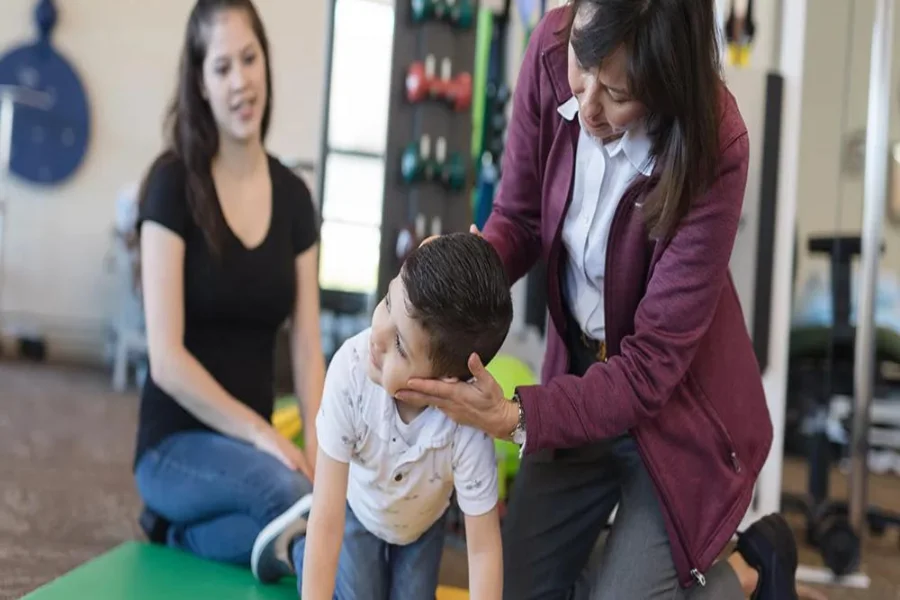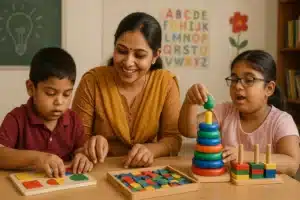
Source: thetransmitter
Understanding the necessary “Shadow Teacher Qualification” is crucial for those interested in supporting children with unique learning needs. A shadow teacher provides personalized assistance within mainstream classrooms, ensuring children with special needs receive guidance suited to their pace and style.
To become a qualified shadow teacher, candidates typically need a minimum of 10th-grade education, along with a specialized “Shadow Teacher Training Course” from institutions like Vidhyanidhi Education Society (Govt. Regd.) . This course equips aspiring shadow teachers with the skills to foster a positive learning environment and meet the specific requirements of their role.
For more details on the STT Course Call/Whatsapp at +919321024137 / +919869866277
To download the brochure of the STT Course, Click Here!
What is Duration of Shadow Teacher Training Course?
The duration of Shadow Teacher Training Course depends upon each Institution but typically it takes around one year. With “Shadow Teacher Qualification” requirements met, candidates gain practical knowledge on how to adapt lessons, manage behavior, and provide individualized support.
Completing this course from an established institution like Vidhyanidhi Education Society (Govt. Regd.) ensures that aspiring shadow teachers are well-prepared for their role.
Is a Shadow Teacher a Good Job?
Definitely Yes, a shadow teacher’s job is a highly rewarding one but can indeed be a fulfilling and impactful career, allowing you to make a significant difference in the lives of students with special needs.
Here are several reasons why it’s a good job choice:
Building Independence
Shadow teachers guide students in becoming independent and adapting to new environments.
Enhancing communication Skills
They are trained to provide the precise intervention strategies that help to enhance the communication skills both verbal and non-verbal.
Creating a Safe Space
Through trust-building, shadow teachers provide a secure learning environment.
Promoting Social Development
They help students engage with peers, fostering social growth and acceptance.
Helping the Class Teacher
Shadow teachers assist the main teacher by simplifying instructions and sharing insights into the student’s needs.
Providing Individualized Support
They focus on life skills and confidence-building through tailored support.
Shadow teachers can find opportunities in diverse settings like schools, therapeutic centers, and after-school programs.

Source: raisingchildren
What are Shadow Teaching Methods?
“Shadow Teaching Methods” are specialized strategies that shadow teachers use to support students with learning differences in a classroom environment. These methods are adaptable to individual needs, helping students progress academically, socially, and behaviorally.
Key “Shadow Teaching Methods” include:
Breaking Down Instructions
Simplifying directions to suit the student’s comprehension level.
Using Physical Prompts
Employing gestures or actions to reinforce verbal instructions.
Full Class Support
Accompanying the student across different classes to ensure consistent support.
Explaining Projects and Homework
Clarifying assignments, tests, and homework for better understanding.
Correcting any behavioural issues
Helping students understand the rules and conduct that is expected from them and helping them manage their emotions well in a mainstream classroom setting.
Fostering relationships
Fosters relationships between peers and fellow classmates enhancing their socio-emotional and interaction skills.
Shadow teachers are often trained in child development, behaviour management, and the student’s grade-level curriculum. They collaborate closely with parents, psychologists, and educators to provide a holistic support system, helping students feel more included and confident in their learning environment.
Is Shadow Teaching Different from Special Education?
While taking up the profession of Shadow teaching many aspirants might face this doubt that Is shadow teaching different from Special Education?
So, the answer to this doubt is yes. Shadow teaching is different from Special Education. Special Education is a vast field that encompasses varied learning, behavioral and cognitive disorders and caters to a larger section of children. Shadow Teaching basically focusses on the overall development of a single child, focusing on them and tracking their progress enhancing their learning experiences.
Shadow Teaching
A Shadow teacher refers to a certified educator that is concerned with the overall holistic progress of a single child. The teacher accompanies the child in the classroom giving him the desired one to one attention, devising lesson plans in coordination with the class teacher and tracking the child’s progress. The Shadow teacher also reviews the child’s progress and ascertain if the current teaching methods are helping the child to learn better if no then they make the essential modifications and adaptations in the teaching techniques.
A Shadow teacher also coordinates with the various other professionals who are working on the child’s development such as the occupational therapists, psychologists and other caregivers.
Shadow teachers often tailor their assistance to the student’s learning style, creating an inclusive experience within a typical classroom setting. While “Shadow Teacher Qualification” may vary, shadow teachers often have specialized training but generally need fewer qualifications than special educators.
Special Education
The Special Educators are trained professionals who undergo the required training to gain expertise about a varied range of neurodevelopmental and behavioural disorders and work on improving the skills that help children function better in a normal classroom. They aim to devise exclusive lesson plans keeping in mind the academic needs of the child focussing on his strengths enabling him to achieve his learning goals.
Both shadow teachers and special educators aim to help students succeed, though shadow teachers typically serve as aides, while special educators act as lead instructors with more formal qualifications.

Source: careforautism
What Skills do you need to be a Shadow Teacher?
To be an effective shadow teacher, a diverse set of skills is essential. These skills enable shadow teachers to support students with special needs in mainstream classrooms successfully.
Here are key skills required, alongside a “Shadow Teacher Qualification”:
Clear Lucid Communicator
The Shadow Teacher must be clear in her communication while giving instructions to children at the same time she must establish proper communication link with the parents to describe the child’s progress and overall well-being.
Endurance
Children with learning challenges must be dealt with in a patient soft manner giving them the assurance that they can succeed even if they make mistakes.
Adaptability
Shadow teachers need to adjust teaching strategies to align with each student’s unique learning style.
Observational Skills
Regularly monitoring and assessing a student’s progress helps in creating effective support plans.
Comforting Presence
Teachers should understand the challenges that affect the well-being of the child and provide the child that empathizing comfort promoting a conducive learning atmosphere.
Collaboration
Working closely with teachers, parents, and other specialists ensures a cohesive support system.
Knowledge of Special Education
Familiarity with special education principles enables shadow teachers to apply effective methods.
Behaviour Management
Skill in managing behaviours like restlessness helps maintain focus and engagement.
With a strong foundation in these skills, along with proper qualifications, shadow teachers can provide meaningful support that enhances a student’s learning experience.
“Transform lives by Enrolling in Vidhyanidhi Education Society’s STT Course today!”
For more details on the STT Course Call/Whatsapp at +919321024137 / +919869866277
To download the brochure of the STT Course, Click Here!
FAQs
Can a Mother be a Shadow Teacher?
Yes, a mother can be a shadow teacher if she meets the necessary qualifications and training. Vidhyanidhi Education Society offers relevant courses to help her get started.
Who Pays for Shadow Teacher?
The shadow teacher is generally paid by the parents of the child as this job role involves supporting only a single child by physically accompanying the child focusing only on him.
What is the Salary of a Shadow Teacher?
The salary of a shadow teacher is dependant on various aspects such as the educational credentials, experience level, and the demographic factor of the school.



